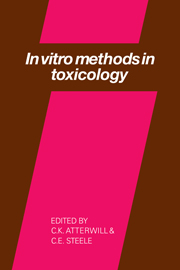Book contents
- Frontmatter
- Contents
- List of contributors
- Preface
- Introduction
- TARGET ORGAN TOXICITY
- GENERAL AND TOPICAL TOXICITY
- REPRODUCTIVE TOXICITY
- An in vitro test for teratogens using cultures of rat embryo cells
- Postimplantation embryo culture and its application to problems in teratology
- Sub-mammalian and sub-vertebrate models in teratogenicity screening
- The use of in vitro techniques to investigate the action of testicular toxicants
- An in vitro assessment of ovarian function: a potential tool for investigating mechanisms of toxicity in the ovary
- CONCLUSION
- Index
Sub-mammalian and sub-vertebrate models in teratogenicity screening
Published online by Cambridge University Press: 06 August 2010
- Frontmatter
- Contents
- List of contributors
- Preface
- Introduction
- TARGET ORGAN TOXICITY
- GENERAL AND TOPICAL TOXICITY
- REPRODUCTIVE TOXICITY
- An in vitro test for teratogens using cultures of rat embryo cells
- Postimplantation embryo culture and its application to problems in teratology
- Sub-mammalian and sub-vertebrate models in teratogenicity screening
- The use of in vitro techniques to investigate the action of testicular toxicants
- An in vitro assessment of ovarian function: a potential tool for investigating mechanisms of toxicity in the ovary
- CONCLUSION
- Index
Summary
INTRODUCTION
The ‘multi-tier’ approach has been adopted in several areas of toxicity testing, particularly in screening for carcinogens and mutagens. The overall philosophy is to establish a range of test systems of increasing biological complexity, from quick simple pre-screens, such as the Ames test, to highly complex whole mammal tests. An individual test agent is directed through these tests according to test results, likely human exposure and use of the chemical. For example, an environmental pollutant that occurs in very low concentrations and to which human exposure is extremely low and which, by pre-screen, is demonstrably non-toxic, would probably not be referred for further testing. On the other hand, a toxic response elicited in a pre-screen would dictate that further more elaborate test procedures were called for. Similarly, further testing would probably be required of a chemical that, although non-toxic in pre-screen, was relatively abundant in the environment. The major reasons for taking this step-wise approach are that the whole mammal tests routinely used in the past are time-consuming, expensive, require great expertise and are wasteful of all resources, including experimental mammals. The number of untested chemicals far exceeds the capacity to test them by whole-mammal methods. Hence there is a need to reserve these tests for those agents identified by pre-screens as likely to constitute the greatest hazard to man.
The past ten years have seen the development of the multi-tier approach to tackle the problem of teratogenicity testing.
- Type
- Chapter
- Information
- In Vitro Methods in Toxicology , pp. 391 - 410Publisher: Cambridge University PressPrint publication year: 1987
- 5
- Cited by



